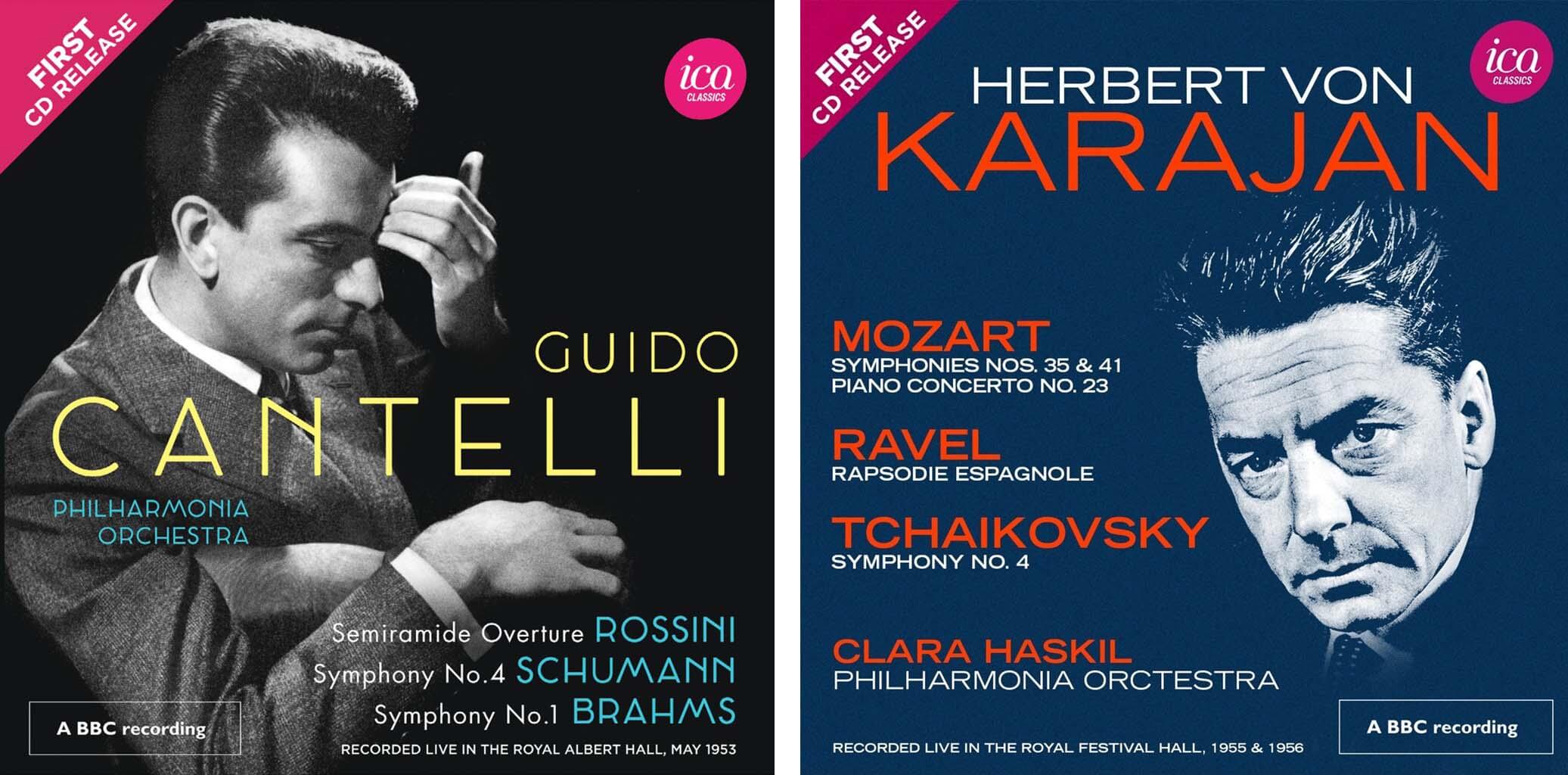
Mozart: Symphonies 35 & 41. Piano Concerto No. 23. Ravel: Rapsodie Espagnole. Tchaikovsky: Symphony No. 4. Clara Haskil, piano. Philharmonia Orchestra/Herbert von Karajan. Recorded live 1955-56. ICA Classics ICAC 5142 (2 CDs). Total Time: 129:32. // Rossini: Semiramide Overture. Schumann: Symphony No. 4. Brahms: Symphony No. 1. Philharmonia Orchestra/Guido Cantelli. Recorded live 1953. ICA Classics ICAC 5143. Total Time: 79:30.
Walter Legge was a record producer at EMI in London when, in 1945, right after the war, he decided to form the Philharmonia Orchestra, primarily as a recording ensemble. The orchestra, comprised of many of the best players in England, quickly established itself as one of London’s premier orchestras and soon, in addition to its recording work, was giving concerts and touring.
Herbert von Karajan began to work with the Philharmonia in 1949 and became its unofficial principal conductor. On November 11, 1955, Karajan and the Philharmonia appeared at Massey Hall in Toronto in a program of Britten, Beethoven and Debussy. Too busy with the Berlin Philharmonic, the Vienna State Opera and La Scala to continue the association, Karajan made his last appearances with the Philharmonia in 1960.
Between 1949 and 1960, Karajan made a vast number of recordings with the Philharmonia and led most of its European and North American tours. Many of the London concerts by the Philharmonia were broadcast on the BBC but have never before been commercially available. In fact, the BBC itself has not preserved many of these broadcasts; fortunately, one dedicated music lover named Richard Itter took it upon himself to record dozens of these concerts off the air for his own use. Now, years later, some of Itter’s tapes have been released by ICA Classics. The recorded sound, although based on AM radio broadcasts, is of surprisingly good quality and the performances I have heard so far are remarkably good.
I grew up on many of the Karajan Philharmonia recordings — they were released in North America on the Angel label — and they struck me at the time of their release as being impeccably played and recorded, albeit often lacking in spontaneity. Many of the pieces captured in BBC broadcasts were also recorded in a studio before or after live concerts. Comparisons between the live broadcasts and the studio recordings reveal two things: the Philharmonia Orchestra really was that good, and Karajan “live” was infinitely more exciting and unpredictable than Karajan in the studio. The live performance of the Tchaikovsky Fourth from May 1, 1955, has nearly every detail in place as well as a gripping intensity from beginning to end.
Although pianist Clara Haskil and Karajan often performed together, they were unable to record together because they were under contract to two different record companies. That said, we now have a fine documentation of one of their collaborations from the Itter Collection. Their performance of Mozart’s K. 488 from February 6, 1956, is as beautiful a reading of this concerto as one could imagine.
Guido Cantelli was a gifted Toscanini protégée who would have joined the ranks of the greatest conductors had he not lost his life in a plane crash in November 1956 at the age of only 36. Cantelli gave 28 concerts and made a substantial number of recordings with the Philharmonia Orchestra. On this ICA CD, we have a complete concert from the Itter Collection given at the Royal Albert Hall, May 11, 1953. As in the case of the Karajan performances discussed earlier, the Philharmonia played magnificently for Cantelli.
Cantelli’s interpretations of works by Rossini, Schumann and Brahms certainly remind me of Toscanini in their hair-trigger precision and forward motion, but Cantelli is very much his own man too. Definitely not Toscanini imitations, these performances are not only tightly controlled, but also shaped with grace and sensitivity. On first hearing, Cantelli’s Semiramide might seem to suffer from over-zealous trumpets and percussion — perhaps the BBC engineers had some problems with balance in the cavernous acoustics of the Royal Albert Hall — but who cares? The overall impression is of joyful and thrilling music-making. The Schumann and Brahms are up to this same high standard. The solo horn playing in the Brahms — probably by an uncredited Dennis Brain — is sublime. Cantelli adds some tastefully executed timpani rolls in the climactic chorale at the end of the Brahms. Both Toscanini and Furtwängler did similar retouching.
ICA Classics has also released a 4-CD set of Klemperer live performances from the Itter Collection (ICAC 5145). Hopefully, there will be more Itter releases to come.
LUDWIG VAN TORONTO
Want more updates on Toronto-centric classical music news and reviews before anyone else finds out? Follow us on Facebook or Twitter for all the latest.
![]()
- SCRUTINY | TSO Lets Berlioz Do The Talking In Season Opener - September 21, 2018
- RECORD KEEPING | Even Yannick Nézet-Séguin Can’t Make Us Love Mozart’s La Clemenza di Tito - September 6, 2018
- RECORD KEEPING | Giovanna d’Arco With Anna Netrebko Explains Why The Best Operas Survive - August 30, 2018



